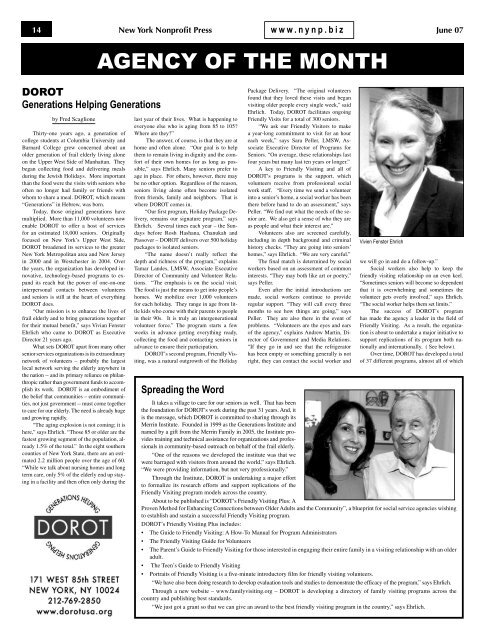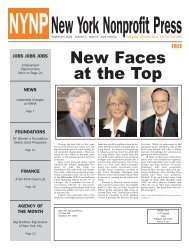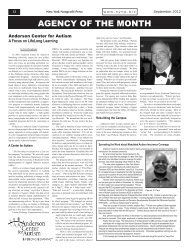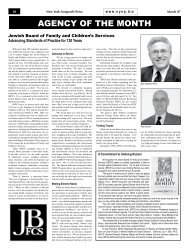dorot - New York Nonprofit Press
dorot - New York Nonprofit Press
dorot - New York Nonprofit Press
Create successful ePaper yourself
Turn your PDF publications into a flip-book with our unique Google optimized e-Paper software.
14 <strong>New</strong> <strong>York</strong> <strong>Nonprofit</strong> <strong>Press</strong> www.nynp.biz June 07<br />
AGENCY OF THE MONTH<br />
DOROT<br />
Generations Helping Generations<br />
by Fred Scaglione<br />
Thirty-one years ago, a generation of<br />
college students at Columbia University and<br />
Barnard College grew concerned about an<br />
older generation of frail elderly living alone<br />
on the Upper West Side of Manhattan. They<br />
began collecting food and delivering meals<br />
during the Jewish Holidays. More important<br />
than the food were the visits with seniors who<br />
often no longer had family or friends with<br />
whom to share a meal. DOROT, which means<br />
“Generations” in Hebrew, was born.<br />
Today, those original generations have<br />
multiplied. More than 11,000 volunteers now<br />
enable DOROT to offer a host of services<br />
for an estimated 18,000 seniors. Originally<br />
focused on <strong>New</strong> <strong>York</strong>’s Upper West Side,<br />
DOROT broadened its services to the greater<br />
<strong>New</strong> <strong>York</strong> Metropolitan area and <strong>New</strong> Jersey<br />
in 2000 and in Westchester in 2004. Over<br />
the years, the organization has developed innovative,<br />
technology-based programs to expand<br />
its reach but the power of one-on-one<br />
interpersonal contacts between volunteers<br />
and seniors is still at the heart of everything<br />
DOROT does.<br />
“Our mission is to enhance the lives of<br />
frail elderly and to bring generations together<br />
for their mutual benefit,” says Vivian Fenster<br />
Ehrlich who came to DOROT as Executive<br />
Director 21 years ago.<br />
What sets DOROT apart from many other<br />
senior services organizations is its extraordinary<br />
network of volunteers – probably the largest<br />
local network serving the elderly anywhere in<br />
the nation -- and its primary reliance on philanthropic<br />
rather than government funds to accomplish<br />
its work. DOROT is an embodiment of<br />
the belief that communities – entire communities,<br />
not just government -- must come together<br />
to care for our elderly. The need is already huge<br />
and growing rapidly.<br />
“The aging explosion is not coming; it is<br />
here,” says Ehrlich. “Those 85 or older are the<br />
fastest growing segment of the population, already<br />
1.5% of the total.” In the eight southern<br />
counties of <strong>New</strong> <strong>York</strong> State, there are an estimated<br />
2.2 million people over the age of 60.<br />
“While we talk about nursing homes and long<br />
term care, only 5% of the elderly end up staying<br />
in a facility and then often only during the<br />
last year of their lives. What is happening to<br />
everyone else who is aging from 85 to 105<br />
Where are they”<br />
The answer, of course, is that they are at<br />
home and often alone. “Our goal is to help<br />
them to remain living in dignity and the comfort<br />
of their own homes for as long as possible,”<br />
says Ehrlich. Many seniors prefer to<br />
age in place. For others, however, there may<br />
be no other option. Regardless of the reason,<br />
seniors living alone often become isolated<br />
from friends, family and neighbors. That is<br />
where DOROT comes in.<br />
“Our first program, Holiday Package Delivery,<br />
remains our signature program,” says<br />
Ehrlich. Several times each year – the Sundays<br />
before Rosh Hashana, Chanukah and<br />
Passover – DOROT delivers over 500 holiday<br />
packages to isolated seniors.<br />
“The name doesn’t really reflect the<br />
depth and richness of the program,” explains<br />
Tamar Landes, LMSW, Associate Executive<br />
Director of Community and Volunteer Relations.<br />
“The emphasis is on the social visit.<br />
The food is just the means to get into people’s<br />
homes. We mobilize over 1,000 volunteers<br />
for each holiday. They range in age from little<br />
kids who come with their parents to people<br />
in their 90s. It is truly an intergenerational<br />
volunteer force.” The program starts a few<br />
weeks in advance getting everything ready,<br />
collecting the food and contacting seniors in<br />
advance to ensure their participation.<br />
DOROT’s second program, Friendly Visiting,<br />
was a natural outgrowth of the Holiday<br />
Spreading the Word<br />
Package Delivery. “The original volunteers<br />
found that they loved these visits and began<br />
visiting older people every single week,” said<br />
Ehrlich. Today, DOROT facilitates ongoing<br />
Friendly Visits for a total of 300 seniors.<br />
“We ask our Friendly Visitors to make<br />
a year-long commitment to visit for an hour<br />
each week,” says Sara Peller, LMSW, Associate<br />
Executive Director of Programs for<br />
Seniors. “On average, these relationships last<br />
four years but many last ten years or longer.”<br />
A key to Friendly Visiting and all of<br />
DOROT’s programs is the support, which<br />
volunteers receive from professional social<br />
work staff. “Every time we send a volunteer<br />
into a senior’s home, a social worker has been<br />
there before hand to do an assessment,” says<br />
Peller. “We find out what the needs of the senior<br />
are. We also get a sense of who they are<br />
as people and what their interest are.”<br />
Volunteers also are screened carefully,<br />
including in depth background and criminal<br />
history checks. “They are going into seniors’<br />
homes,” says Ehrlich. “We are very careful.”<br />
The final match is determined by social<br />
workers based on an assessment of common<br />
interests. “They may both like art or poetry,”<br />
says Peller.<br />
Even after the initial introductions are<br />
made, social workers continue to provide<br />
regular support. “They will call every three<br />
months to see how things are going,” says<br />
Peller. They are also there in the event of<br />
problems. “Volunteers are the eyes and ears<br />
of the agency,” explains Andrew Martin, Director<br />
of Government and Media Relations.<br />
“If they go in and see that the refrigerator<br />
has been empty or something generally is not<br />
right, they can contact the social worker and<br />
Vivien Fenster Ehrlich<br />
we will go in and do a follow-up.”<br />
Social workers also help to keep the<br />
friendly visiting relationship on an even keel.<br />
“Sometimes seniors will become so dependent<br />
that it is overwhelming and sometimes the<br />
volunteer gets overly involved,” says Ehrlich.<br />
“The social worker helps them set limits.”<br />
The success of DOROT’s program<br />
has made the agency a leader in the field of<br />
Friendly Visiting. As a result, the organization<br />
is about to undertake a major initiative to<br />
support replications of its program both nationally<br />
and internationally. ( See below).<br />
Over time, DOROT has developed a total<br />
of 37 different programs, almost all of which<br />
It takes a village to care for our seniors as well. That has been<br />
the foundation for DOROT’s work during the past 31 years. And, it<br />
is the message, which DOROT is committed to sharing through its<br />
Merrin Institute. Founded in 1999 as the Generations Institute and<br />
named by a gift from the Merrin Family in 2005, the Institute provides<br />
training and technical assistance for organizations and professionals<br />
in community-based outreach on behalf of the frail elderly.<br />
“One of the reasons we developed the institute was that we<br />
were barraged with visitors from around the world,” says Ehrlich.<br />
“We were providing information, but not very professionally.”<br />
Through the Institute, DOROT is undertaking a major effort<br />
to formalize its research efforts and support replications of the<br />
Friendly Visiting program models across the country.<br />
About to be published is “DOROT’s Friendly Visiting Plus: A<br />
Proven Method for Enhancing Connections between Older Adults and the Community”, a blueprint for social service agencies wishing<br />
to establish and sustain a successful Friendly Visiting program.<br />
DOROT’s Friendly Visiting Plus includes:<br />
• The Guide to Friendly Visiting: A How-To Manual for Program Administrators<br />
• The Friendly Visiting Guide for Volunteers<br />
• The Parent’s Guide to Friendly Visiting for those interested in engaging their entire family in a visiting relationship with an older<br />
adult.<br />
• The Teen’s Guide to Friendly Visiting<br />
• Portraits of Friendly Visiting is a five-minute introductory film for friendly visiting volunteers.<br />
“We have also been doing research to develop evaluation tools and studies to demonstrate the efficacy of the program,” says Ehrlich.<br />
Through a new website – www.familyvisiting.org – DOROT is developing a directory of family visiting programs across the<br />
country and publishing best standards.<br />
“We just got a grant so that we can give an award to the best friendly visiting program in the country,” says Ehrlich.
June 07 <strong>New</strong> <strong>York</strong> <strong>Nonprofit</strong> <strong>Press</strong> www.nynp.biz 15<br />
AGENCY OF THE MONTH<br />
involve interactions between multi-generational<br />
volunteers and seniors.<br />
DOROT arranges cemetery trips for seniors<br />
to visit the graves of family and friends.<br />
“This goes back 25 years,” says Ehrlich.<br />
“Seniors are desperate to make these visits,”<br />
says Landes. “Volunteers escort them to<br />
cemeteries throughout the greater metropolitan<br />
area. We find out where relatives are buried.<br />
We train volunteers in how to escort seniors<br />
physically if they have wheelchairs or walkers.<br />
We also prepare them for the emotional aspects<br />
of the visit. Volunteers are always surprised.<br />
They expect it to be a very depressing experience<br />
and they always come back completely<br />
uplifted. It is a great day, a celebration of the<br />
life of the person they are visiting.” DOROT’s<br />
program uses individual car services for groups<br />
of two or three seniors in order to reduce the logistical<br />
problems. “A lot of our people are too<br />
frail for busses or vans. It would be too difficult<br />
waiting for large groups.”<br />
A Thanksgiving Program evolved from<br />
an early gift of 100 turkeys from a local kosher<br />
butcher. “The board was up all night cooking<br />
and invited the seniors in to a big dinner,”<br />
says Ehrlich. These days, DOROT hosts 250<br />
seniors at an annual banquet at congregation<br />
Rodeph Shalom while volunteers deliver an<br />
equal number of Thanksgiving dinners to seniors<br />
who are too frail to leave home. Once<br />
again, the focus is more on the visit than the<br />
meal. “It is not like a volunteer just picks<br />
up 30 meals and drops them off,” says Landes.<br />
“They go and sit and visit. That is what<br />
launches these ongoing relationships.”<br />
Interestingly, DOROT does have one<br />
meals delivery program in which a paid<br />
staff member drops off kosher meals – frozen<br />
meals – on a weekly basis. The program<br />
serves over 265 people a year. “Last year we<br />
delivered 40,000 meals,” says Ehrlich.<br />
A similar approach has drawn a storm of<br />
criticism from senior services agencies when<br />
piloted by <strong>New</strong> <strong>York</strong> City’s Department for<br />
the Aging (DFTA) in the Bronx. Ehrlich<br />
finds the comparisons ironic – and inaccurate.<br />
For one thing, DFTA was originally critical of<br />
the DOROT program – which was launched<br />
in 1983 – because of the frozen food component.<br />
Nevertheless, DFTA has come to see<br />
the merits of the DOROT program and continues<br />
to fund it.<br />
More importantly, Ehrlich stresses that<br />
the DOROT program features intensive telephone<br />
reassurance for the participating seniors.<br />
“We have volunteers, usually other<br />
seniors, who call each person on the meal<br />
program each week to take their order,” says<br />
Peller. “They develop strong relationships.<br />
Our program also has a very strong social<br />
work component. We go out to the homes to<br />
do assessments.” With this level of support,<br />
together with DOROT’s other programmatic<br />
contacts, the once-weekly delivery of meals<br />
actually promotes independence and autonomy,<br />
allowing seniors to eat the meals they<br />
want, when they want.<br />
University without Walls, another initiative<br />
dating back to the late 1980s seems<br />
innovative even today. “We had a support<br />
group that was meeting in Lincoln Towers<br />
and in the winter people wouldn’t cross the<br />
yard to come to meetings,” explains Ehrlich.<br />
DOROT turned to technology and began running<br />
the group via telephone conference calls.<br />
“The group ran for three more years,” says<br />
Ehrlich. “Based on that success, we decided<br />
to try doing a current events and a music class<br />
the same way. We got 36 people to register.”<br />
Today, DOROT’s University without<br />
Walls offers 250 different courses ranging<br />
from poetry and literature to visual arts, computers,<br />
health, history and political science.<br />
“Every hour on the hour we are running<br />
two classes simultaneously,” says Ehrlich.<br />
“People can sign up for one or<br />
two classes. We have had one<br />
person sign up for 23 different<br />
classes. Seniors from Westchester<br />
or Staten Island can come<br />
together by phone and share a<br />
class from the Museum of Modern<br />
Art. We work with every<br />
museum in <strong>New</strong> <strong>York</strong> City.”<br />
The University without<br />
Walls classes are given by 125<br />
facilitators, the majority of<br />
whom are volunteers. Miriam<br />
Herman, a retired college professor,<br />
offered a recent series<br />
of programs on “Hollywood<br />
Legends” from her home in<br />
Florida. A half dozen seniors<br />
from around the metropolitan<br />
area came on the line to discuss<br />
the lives and movies of Katherine<br />
Hepburn and Spencer Tracy,<br />
two stars whom the participants<br />
remembered from their own<br />
youths, well before these films<br />
were considered “old movies”.<br />
“My daughter signed me up<br />
for this and I am very glad she<br />
did,” said one class member. “I<br />
look forward to it all week.”<br />
The program has also spawned a series<br />
of spin-offs, including Russian University<br />
without Walls for recent immigrants and<br />
Caregivers’ Connection Support Groups for<br />
people who are caring for loved ones.<br />
University without Walls was honored<br />
in 1999by the United Nations as one of the<br />
twelve most innovative programs for the elderly<br />
in the United States. In total, more than<br />
1,000 seniors now participate in DOROT’s<br />
three telephone-based programs.<br />
DOROT’s other programs which serve<br />
homebound seniors include an extensive Information<br />
and Referral Service – (“It’s our<br />
largest program,” says Ehrlich. “Last year<br />
we provided 140,000 units of information.”)<br />
– and an Escort Program that offers transportation<br />
for medical visits and shopping.<br />
In 1983, DOROT also began providing<br />
critical services for seniors who do not have<br />
a home of their own. The Homelessness Prevention<br />
Program offers transitional shelter<br />
for elderly who are homeless. “It was in response<br />
to a plea by Mayor Koch,” says Ehrlich.<br />
The program operates out of a single<br />
room occupancy hotel on 95th Street and can<br />
accommodate 14 people. “This is the only<br />
transitional housing program for seniors<br />
which operates outside of the DHS shelter<br />
system,” says Peller.<br />
“If you mix seniors with a younger population,<br />
they are preyed upon,” says Martin.<br />
“At HPP we are offering services which are<br />
tailored to meet their specific needs. Since<br />
we operate outside the DHS bureaucracy, we<br />
are able do the kinds of aftercare that is effective.”<br />
DOROT’s approach pays off. “We have<br />
a 98% success rate in preventing the recurrence<br />
of homelessness,” says Peller. “Over<br />
the life of the program we have relocated<br />
about 1,500 people to permanent housing.”<br />
Typically, while HPP is a program,<br />
which receives some government funding,<br />
DOROT privately finances much of the operation.<br />
In all, only 6% of DOROT’s finances<br />
come through government contracts. “We are<br />
a rare type of social service agency,” says Ehrlich.<br />
More than half of DOROT’s $6 million<br />
annual budget comes through individual donations.<br />
“One of our first presidents, Jonathan<br />
<strong>New</strong>house, got us started with direct mail,”<br />
says Ehrlich. “We do over 100,000 mailings<br />
a year and we have over 30,000 individual donors.”<br />
The agency also has a strong base of<br />
70 foundation and corporate supporters, accounting<br />
for about one-third of all revenues.<br />
“This has given us the independence to<br />
develop programs based on what we see as the<br />
evolution of needs,” says Ehrlich. And, those<br />
needs continue to grow. The average age of<br />
DOROT’s clients is now 87, up from the mid-<br />
70s when it was first created. One-third are<br />
blind or visually impaired and 75% live in<br />
poverty with income of less than $15,000.<br />
In response, DOROT is continuing to enlist<br />
new generations of <strong>New</strong> <strong>York</strong>ers to assist<br />
their elders.<br />
“More than 3,500 of our volunteers are<br />
under the age of 18,” says Ehrlich. Many of<br />
these younger volunteers come through DOR-<br />
OT’s partnership programs with 156 different<br />
public and private schools. “A lot of schools<br />
have public service requirements,” says Landes.<br />
“Kids come during school breaks. They<br />
work in shopping programs and help us collect<br />
and pack meals.”<br />
Still other younger volunteers are born<br />
into the DOROT tradition of service. “This is<br />
a family affair. We have original volunteers<br />
who started as singles, got married and are<br />
now coming with their children,” says Ehrlich.<br />
“One of the reasons we have been so successful<br />
is that volunteers get enormous bang out<br />
of their investment of time here. They come<br />
because they want to give something, but they<br />
find they get so much more in return. ”<br />
This announcement space is available to current and former grantees of the Child Welfare Fund.<br />
To use this space please contact publisher@nynp.biz











